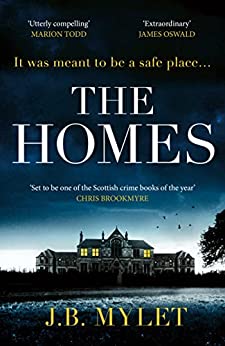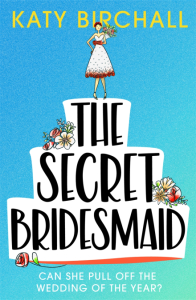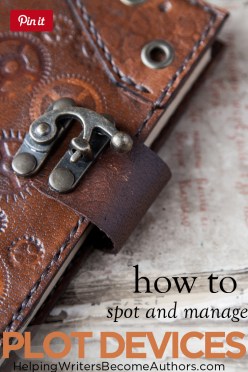 What are plot devices? Basically, they’re exactly what they sound like: events that maneuver the plot in particular directions.
What are plot devices? Basically, they’re exactly what they sound like: events that maneuver the plot in particular directions.
All stories are built on plot devices. In truth, everything that happens in a story is a plot device. Story structure beats are plot devices. Character arc beats are plot devices. Plot devices are the little clockwork gears that make a story run.
This means plot devices are also one of a writer’s most important tools. Need to figure out a way to get two characters to show up at the same place at the same time? A plot device is your key. Want two characters to have good reason to hate each other? Plot device!
This isn’t a bad thing. However, the term “plot device” often comes with the negative connotations associated with poorly executed moments that feel contrived or like authors are manipulating events in order to make the plot do what they want.
Now, of course, all writers must “manipulate” the plot to some extent. After all, we’re not just responsible for creating the story, we’re also responsible for steering it. We know we need to get the characters from Point A to Point B, which means coming up with plausible plot devices to move them along the road toward the final Climax.
The trick is to do so in a way that honors the entire context of the story. Each event should arise naturally from the story’s cause and effect. Any time something in a story seems to exist solely to explain a previous event or further a future event, that’s the sign of a contrived plot device. By contrast, a successful plot device is one that seems to exist solely for its own sake—as if it were just as important as any other event—which allows it to seamlessly integrate with the rest of the story.
What Are Plot Devices? 8 Possibilities
This topic is on my mind right now, as I’ve been brainstorming my way around the need for a particular plot device in my fantasy work-in-progress Wildblood. Today, I want to talk about how you can recognize obvious plot devices and then how to troubleshoot your own process to determine whether or not the plot devices will seem contrived to readers.
To get us started, here are eight possible ways plot devices may show up in your story.
1. Event
At its simplest, a plot device is something that happens in your story. It could be a birth, a death, a robbery, a wedding, a dance-off, a scam—you name it. Most of the time, we refer to these events as “beats” or “scenes.” We usually only think of them as plot devices when they seem contrived—as if the only reason an event is happening is to either facilitate a different scene or to instigate a particular emotion in readers.
For Example: In Jupiter Ascending, the main characters are betrayed by a friend—an event that exists solely to facilitate certain subsequent plot developments and that is not supported by either proper build-up or motive or by emotional consequences after the fact.
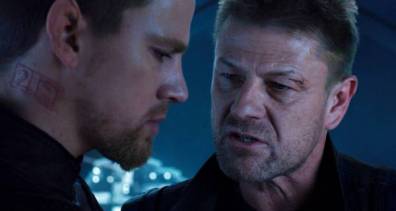
Jupiter Ascending (2015), Warner Bros.
2. Info
Anything that changes the plot moves the plot, something information is capable of doing all by itself. Any time a character learns something new, that’s a plot device. Readers will always trust that new information is important to the story. However, if that information exists only to be interesting in the moment, without being paid off later, then it is likely a poorly executed plot device.
For Example: This one is common in jargon-heavy or worldbuilding-centric stories, which often drop lots of info, not all of which is necessary either for advancing the plot or even just fleshing out the world. In the adaptation of The Witcher, the “cost of magic” (demonstrated by a girl’s hand withering after performing magic) is used as a device to inform the plot early on, but then dropped from the narrative when it becomes inconvenient.
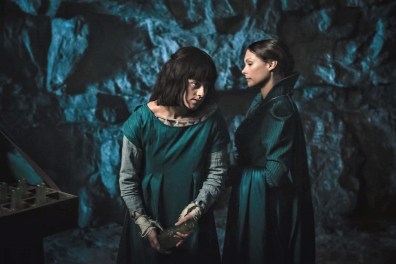
The Witcher (2019-), Netflix.
3. MacGuffin
A MacGuffin, as Alfred Hitchcock famously called it, is a thing or person that inspires pursuit throughout the story. The falcon statuette in The Maltese Falcon is one of the most famous examples. A MacGuffin can also be a person or even just a bit of information. This is a powerful plot device, but it only works well when the MacGuffin is not incidental. It needs to be there for more than just a reason to keep the characters moving; it needs to offer meaning to both plot and theme by the end.
For Example: A popular MacGuffin in recent film was the Tesseract in the MCU, which characters pursued through multiple entries in the series. Ultimately, it was a successful plot device, since it remained important to the very end of the original plotline, when it was claimed by the arch-villain Thanos as one of the Infinity Stones.

The Avengers: Infinity War (2018), Marvel Studios.
4. Suspense/Cliffhanger
Poorly wrought plot devices are often designed to manipulate readers. Now, ultimately, it is a writer’s job to guide the readers’ experience. And to control your readers’ experience, you must control both expectation and emotion. Suspense is a powerful tool for accomplishing both. However, it must be wielded so as to reward trust. If suspense is built or if a cliffhanger is employed, only for the subsequent scenes to dwindle the anxiety and/or outright fool readers, the effect is usually jarring at best and off-putting at worst.
For Example: This a low-key example, but when I think about this trick, I always think of a scene in a Dick Van Dyke Show episode, in which the opening scene has protagonist Rob bursting into the kitchen in a panic to tell his wife “the police are here for us!”—only to have the next scene, after the opening credits, reveal that the police are there for totally mundane reasons.
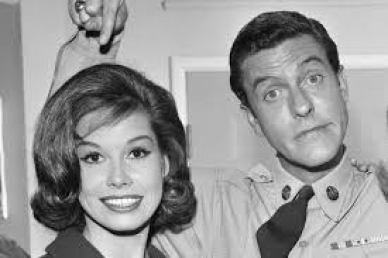
The Dick Van Dyke Show (1961-66), CBS.
5. Conundrums
Much of plot revolves around creating conundrums for characters to solve. This is true simply on the level of scene structure, in which a character’s goal will be met with an obstacle, which inspires the need for a solution. It is even more obviously true in genres such as Mystery, which focus entirely on solving puzzles. However, writers must be careful not to create conundrums for the sake of conundrums. If your character has to spend time figuring out something that doesn’t impact or matter to the overall story, then ultimately you’re just wasting readers’ time.
For Example: Much of the plot in Season 4 of Stranger Things revolves around solving the mystery of whether or not a local man savagely murdered his family many decades ago. Because solving this mystery proves crucial to the present-day plotline in which characters are trying to rescue one of their own from a similar fate, the plot device works. Had it not tied together so cohesively, it would have been problematic.
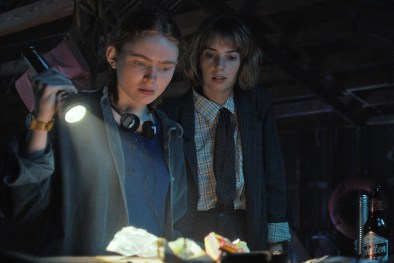
Stranger Things (2016-), Netflix.
6. Plot Twist
A plot twist can be one of the most enjoyable types of plot device. It can also be one of the most abused. A plot twist should never exist just for the sake of the twist. It should be a natural and inevitable outgrowth of everything that’s come before and should matter to what comes after. If you could pull the twist without affecting the progression of the plot, you know you’re probably looking at a manipulative plot device.
For Example: For my money, one of the most annoying plot twists was the out-of-left-field reveal in The Avengers: Age of Ultron that Clint Barton/Hawkeye had a secret family. It doesn’t seem so bad in retrospect, since the franchise built on it in subsequent episodes. But at the time, it lacked any setup and felt super-manipulative.
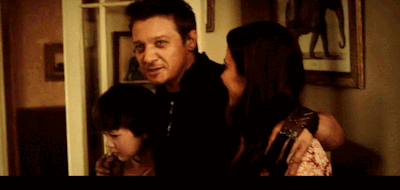
The Avengers: Age of Ultron (2015), Marvel Studios.
7. Bad Guy Motivation
Even in stories that beautifully execute the main throughline for the protagonist, clunky plot devices can sneak in as an attempt to justify the antagonist’s motivation. For example, if the bad guy wants the MacGuffin, he must want it for a true reason and not “just because it’s there.” Writers sometimes end up concocting convoluted backstories for bad guys in order to get them to behave in ways that are convenient to the plot. But to truly work, the antagonist’s motivation must be just as inherent to the story as is the protagonist’s.
For Example: The plot of Jane Got a Gun revolves around the revenge antagonist John Bishop is intent on taking against protagonist Jane and her husband Ham. However, even the inclusion of a backstory event indicating that Ham once helped Jane escape from Bishop’s brothel, fails to provide a satisfying motivation for why Bishop would risk so much to hunt down and extract revenge from two people who ultimately did him little harm and with whom he had little to no emotional connection.
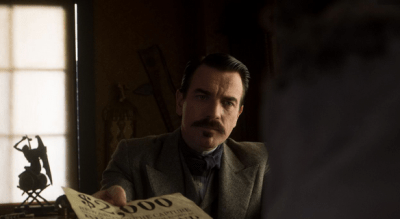
Jane Got a Gun (2015), The Weinstein Company.
8. Flashback
A good flashback should function within the story exactly the same as any other scene: it should entertain, move the plot, be properly set up, and create context for what follows. A bad flashback will just feel like a poorly wrought plot device. This can happen when the author tries to use the flashback to introduce information that controls the audience’s emotional experience in a way that isn’t validated by the rest of the story.
For Example: I wrote a small series recently about how the neo-western series The English butchered its backstory by inserting a poorly set-up flashback into the middle the story, primarily (it would seem) for the reason of milking its full shock value.

The English (2022), BBC Two.
7 Questions to Ask to Identify and Improve Plot Devices
Now that you know some of the ways plot devices might show up in your story, here are seven questions you can ask to analyze how effective any given plot device is within your overall story.
1. Am I Emotionally Attached to This Plot Device?
Neither a yes or a no answer automatically indicates a problem. But it’s valuable to evaluate how much you want this moment to be in the story. It could be you want it in there because it is legitimately great. But it could also be you’re working overtime to include a “darling” that just isn’t a good fit.
2. On a Scale of 1–10, What’s the Shock Value and/or Fan Service?
On the flipside of the previous question, examine your intent for how you want your audience to experience this moment. Are you desiring to create a specific emotion—such as shock? Or maybe you just really want to give them the kind of scene you know they’d love. Either way, recognize that this motivation on your part isn’t enough to prevent the moment from feeling like a poorly wrought plot device. The effect you’re after in any specific scene must be supported by everything else on either side of it.
3. Does This Need to Happen in the Story?
Imagine pulling this scene from your story. What would happen? Would the rest of the story fall apart? If you answer yes, this is usually a sign the scene is indeed cohesive within the larger whole. However, you must also examine whether the reason the story falls apart is because you’ve built everything to lead up to this scene—but it doesn’t make sense after that point. If the scene is crucial to set up a specific part of the story (such as the Climax), but otherwise doesn’t fit the tenor or momentum of the plot, that’s the sign of a poor plot device.
4. Do Previous Events Create the Causal Chain That Leads to the Plot Device?
This is where you take a look at every scene leading up to this one. Are they all a straight line pointing to this moment? Or does it seem like those previous scenes are more logically building to a different conclusion? Too many stories that run into this problem switch gears halfway through as if telling two totally different stories.
5. Does the Device Create Meaning, Context, or Catalyst for Subsequent Events?
Now look at all the scenes that follow the one in question. Do they also form a straight line away from the scene in question, building upon the plot device to naturally create the rest of the story? I always like to think of scenes in a story as a row of dominoes: each one has to bump into the one to follow.
6. Are Characters Properly Motivated to Create This Device?
One of the main reasons plot devices feel hokey is that the characters’ reasons for acting in certain ways just don’t make sense. Often, we know we want a particular scene to happen—e.g., a breakup on the day of the wedding—but unless we use the previous scenes to naturally evolve the characters’ motivations, that scene will ring false when it finally happens. Not only will it fail to provide the desired effect, but it will also likely feel manipulative to audiences.
7. Does This Feel Contrived?
One of the best rules in storytelling is simply: “You can use coincidences to get your characters into trouble, but never to get them out.”
Again, this all comes down to proper setup and foreshadowing. If an event is shoehorned into a story just because the author wants it there, it is likely to feel coincidental and contrived. But if you doublecheck how you’ve developed and portrayed the characters’ motivations, you can show them doing just about anything and readers will swallow it down.
***
What are plot devices? They’re crucial integers in every story at every step. But unless you’re wary of the pitfalls, they can also be potential landmines. Learning how to identify plot devices and fully support them on every page of your story is a huge step toward writing cohesive and resonant fiction.
Wordplayers, tell me your opinions? What are plot devices in your story? How have you handled them? Tell me in the comments!
Click the “Play” button to Listen to Audio Version (or subscribe to the Helping Writers Become Authors podcast in Apple Podcast or Amazon Music).
___
Love Helping Writers Become Authors? You can now become a patron. (Huge thanks to those of you who are already part of my Patreon family!)



